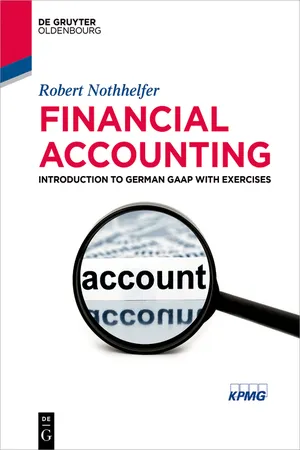
- 301 pages
- English
- ePUB (mobile friendly)
- Available on iOS & Android
Financial Accounting
About this book
Every German student of business administration needs to have a basic understanding of accounting according to German GAAP, and thanks to globalization many courses about German accounting are nowadays held in English to improve the language skills of the students.
In addition many foreign subsidiaries of German companies have to prepare their part of consolidated financial statements according to German GAAP. So far, these professionals can rely on German literature only.
The first part of the book offers a compact introduction to financial statements according to German GAAP, the second part comprises exercises on individual topics with solutions and case studies for in-depth and effective learning.
This introduction provides ideal support for German-speaking students taking Englishspeaking lectures in the field and is furthermore valuable for professionals looking for explanations when preparing the data for consolidated financial statements.
-
- Includes exercises and case studies for practice
- Ideal textbook for students of German Universities attending English-speaking lectures in financial management
- Ideal introduction for professionals with a succinct explanation and additional support with a glossary and vocabulary
Frequently asked questions
- Essential is ideal for learners and professionals who enjoy exploring a wide range of subjects. Access the Essential Library with 800,000+ trusted titles and best-sellers across business, personal growth, and the humanities. Includes unlimited reading time and Standard Read Aloud voice.
- Complete: Perfect for advanced learners and researchers needing full, unrestricted access. Unlock 1.4M+ books across hundreds of subjects, including academic and specialized titles. The Complete Plan also includes advanced features like Premium Read Aloud and Research Assistant.
Please note we cannot support devices running on iOS 13 and Android 7 or earlier. Learn more about using the app.
Information

Part I:Financial statements according to German GAAP
1Introduction to accounting
1.1Purpose of accounting
1.1.1The fundamental question and the fundamental equation
| Cash at the beginning | 10,000 |
| − purchases in cash | − 4,000 |
| − current expenses | − 8,000 |
| + cash from services | 24,000 |
| = cash at end | 22,000 |
| + purchased assets | 6,000 |
| = total assets | 28,000 |
1.1.2Financial and managerial accounting
Table of contents
- Cover
- Title Page
- Copyright
- Preface
- Contents
- Abbreviations
- List of tables
- List of figures
- How to use this book
- Part I: Financial statements according to German GAAP
- Part II: Exercises
- Additional information
- Literature
- Index
- About the author